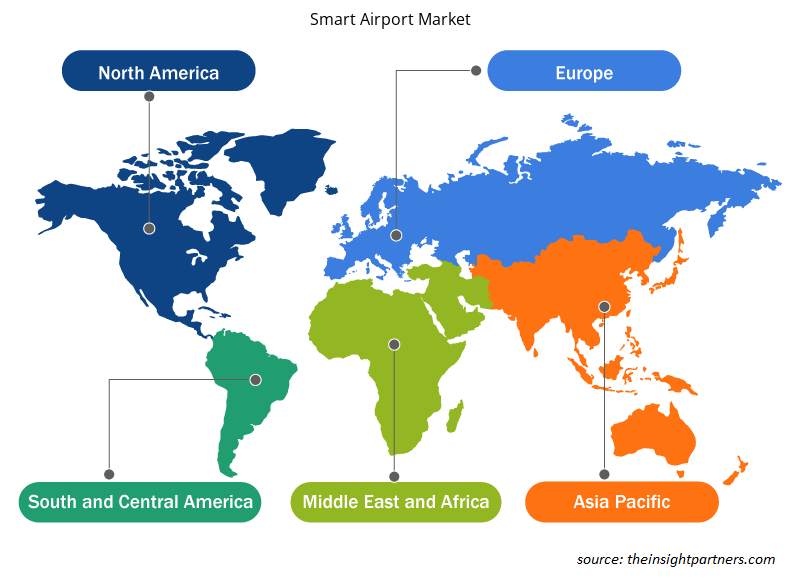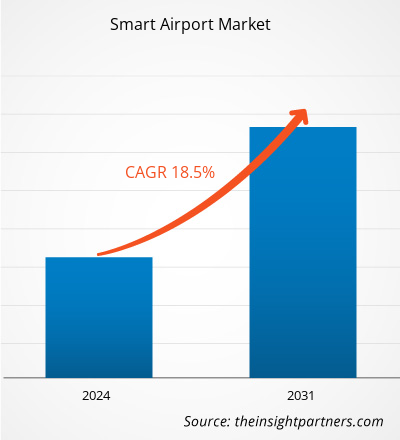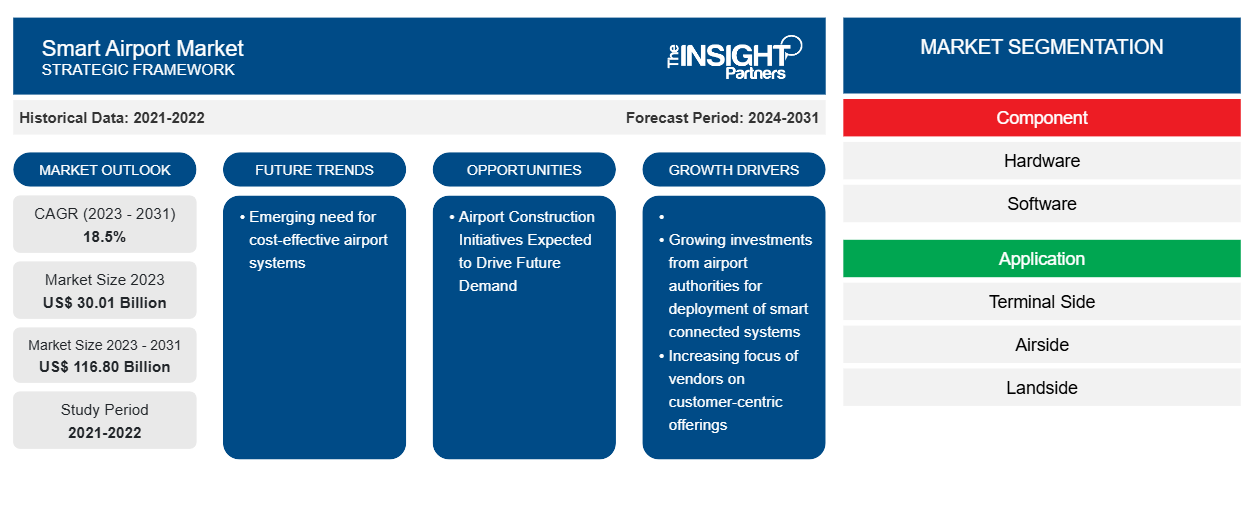智能机场市场规模预计将从 2023 年的 300.1 亿美元增至 2031 年的 1168.0 亿美元。预计 2023-2031 年期间市场复合年增长率将达到 18.5%。对具有成本效益的机场系统的新兴需求可能仍是市场的主要趋势。
智慧机场市场分析
机场采用智能机场系统制造商提供的解决方案和服务。由于不同机场对基于 AI 和 ML 的系统部署的投资不断增加,对智能机场自动化系统的需求正在增加。智能机场生态系统中的组件制造商已与智能技术设备制造商签订了短期和长期合同,例如智能数据处理系统、人工智能生物识别、物联网传感器、调制解调器、路由器和剥离和粘贴传感器。Amadeus IT Group SA、思科系统公司、华为技术有限公司、霍尼韦尔国际公司、Indra Sistemas SA、SABRE GLBL Inc.、Jeppesen、Zensors 和 SITA 是智能机场系统提供商。这些公司为目标终端用户提供端到端的智能设备、服务和解决方案。智能机场系统的主要终端用户包括新加坡樟宜机场、首尔仁川机场、休斯顿机场、东京羽田机场、香港国际机场、多哈哈马德国际机场、慕尼黑机场和伦敦希思罗机场。
智慧机场市场概览
智能机场市场生态系统的主要利益相关者包括零部件制造商和供应商、软件开发商和集成商、智能机场系统制造商和最终用户。零部件制造商和供应商包括 Astronics Corporation、TE Connectivity、Molex、Panduit、Honeywell 和 Schneider Electric 等。政府对智能机场建设的投资不断增加,正在加速机场的数字化。安全性对智能机场至关重要;因此,许多智能机场管理部门正在共同努力,确保这些设施的安全并提高其运营效率。
定制此报告以满足您的需求
您可以免费定制任何报告,包括本报告的部分内容、国家级分析、Excel 数据包,以及为初创企业和大学提供优惠和折扣
-
获取此报告的关键市场趋势。这个免费样品将包括数据分析,从市场趋势到估计和预测。
智能机场市场驱动因素和机遇
市场供应商越来越关注以客户为中心的产品
智能机场行业的公司正致力于提供以客户为中心的解决方案,以促进智能机场技术的采用。全球范围内,乘客对行李追踪的需求不断增长,这是机场当局关注的主要领域之一。根据中国民航局 (CAAC) 的数据,2021 年,中国约 75% 的航空乘客希望了解他们的行李追踪详情和领取时间。根据同一项研究,中国约 86% 的航空公司专注于提供行李追踪通知,57% 的航空公司还向中国各地的乘客提供行李领取信息。因此,智能机场市场的供应商专注于为航空公司提供智能航空行李管理系统,以自动化其业务运营并为乘客提供更好的体验。此类系统与基于云的航空公司应用程序和数据库、基于云的分析以及机器对机器 (M2M) 和物联网平台集成,以连接、管理和保护来自智能行李的实时数据和事件。此外,机场部署行李管理系统也有助于降低整体运营成本,提高整体运营效率。
新机场建设项目
中国和印度等新兴国家的机场建设项目数量不断增加,这可能会在未来几年为市场供应商创造新的机会。政府出台的几项新机场建设和现有机场扩建/升级计划是未来几年可能支持智能机场系统部署的另一个主要因素。例如,印度政府在 2022 年已经宣布了到 2025 年底建设 220 个机场的计划。此外,中国民航局 (CAAC) 在 2018 年宣布了到 2035 年底建设 216 个新机场的计划,到 2035 年机场总数将达到 450 个(2023 年目前为 234 个机场)。这些项目可能会在未来几年为智能机场技术公司创造新的机会。
智能机场市场报告细分分析
有助于得出智能机场市场分析的关键部分是组件和应用。
- 根据组件,智能机场市场分为硬件和软件。硬件部分进一步分为安全系统、通信和导航系统、端点设备和数据存储系统。硬件部分在 2023 年占据了更大的市场份额。
- 根据应用,智能机场市场分为航站楼侧、空侧和陆侧。航站楼侧部分在 2023 年占据了更大的市场份额。
智能机场市场份额(按地区)分析
智能机场市场报告的地理范围主要分为五个地区:北美、欧洲、亚太、中东和非洲、南美。
2023 年,亚太地区占据了市场主导地位,其次是欧洲和北美。此外,亚太地区在未来几年的复合年增长率可能最高。亚太地区智能机场市场的主要驱动力是该地区大量智能机场项目的存在。例如,亚太地区的一些主要智能机场包括香港国际机场、深圳机场、北京大兴国际机场、东京羽田机场、新特丽亚名古屋国际机场、新德里国际机场、海得拉巴国际机场、首尔仁川机场、济州机场、新加坡樟宜机场、吉隆坡国际机场和印度尼西亚机场。此外,中国和印度等国家可能会在 2035 年底前建造 400 多个机场,这可能会在未来几年进一步推动市场发展。
智能机场市场区域洞察
Insight Partners 的分析师已详细解释了预测期内影响智能机场市场的区域趋势和因素。本节还讨论了北美、欧洲、亚太地区、中东和非洲以及南美和中美洲的智能机场市场细分和地理位置。

- 获取智能机场市场的区域特定数据
智能机场市场报告范围
| 报告属性 | 细节 |
|---|---|
| 2023 年的市场规模 | 300.1亿美元 |
| 2031 年市场规模 | 1168亿美元 |
| 全球复合年增长率(2023 - 2031) | 18.5% |
| 史料 | 2021-2022 |
| 预测期 | 2024-2031 |
| 涵盖的领域 |
按组件
|
| 覆盖地区和国家 |
北美
|
| 市场领导者和主要公司简介 |
|
市场参与者密度:了解其对商业动态的影响
智能机场市场正在快速增长,这得益于终端用户需求的不断增长,而这些需求又源于消费者偏好的不断变化、技术进步以及对产品优势的认识不断提高等因素。随着需求的增加,企业正在扩大其产品范围,进行创新以满足消费者的需求,并利用新兴趋势,从而进一步推动市场增长。
市场参与者密度是指在特定市场或行业内运营的企业或公司的分布情况。它表明相对于给定市场空间的规模或总市场价值,有多少竞争对手(市场参与者)存在于该市场空间中。
在智能机场市场运营的主要公司有:
- 霍尼韦尔国际公司
- 思科系统公司
- 华为技术有限公司
- 因陀罗系统公司
- 艾玛迪斯信息技术集团
- 新加坡航空
免责声明:上面列出的公司没有按照任何特定顺序排列。

- 了解智能机场市场顶级关键参与者概况
智能机场市场新闻和最新发展
智能机场市场通过收集一手和二手研究后的定性和定量数据进行评估,其中包括重要的公司出版物、协会数据和数据库。以下列出了智能机场市场的一些发展:
泰雷兹已与机场管理集团 SEA(Società per azioni Esercizi Aeroportuali)签订合同,将提供创新的数字平台解决方案,帮助该集团提高运营效率。(来源:泰雷兹,新闻稿,2022 年 3 月)
- 在 11 月 20 日至 22 日于阿曼马斯喀特举行的首届机场创新展览会上,华为面向国际市场推出了一系列全新的智慧机场解决方案,包括全连接光纤网络解决方案和基于光纤传感的智慧机场周界安全解决方案。(来源:华为,新闻稿,2023 年 11 月)
智能机场市场报告范围和交付成果
“智能机场市场规模和预测(2021-2031)”报告对以下领域进行了详细的市场分析:
- 智能机场市场规模及全球、区域和国家层面所有主要细分市场的预测
- 智能机场市场趋势以及市场动态,如驱动因素、限制因素和关键机遇
- 详细的波特五力分析
- 智能机场市场分析涵盖主要市场趋势、全球和区域框架、主要参与者、法规和最新市场发展
- 行业格局和竞争分析,涵盖市场集中度、热图分析、知名参与者以及智能机场市场的最新发展
- 详细的公司简介
- 历史分析(2 年)、基准年、预测(7 年)及复合年增长率
- PEST和SWOT分析
- 市场规模、价值/数量 - 全球、区域、国家
- 行业和竞争格局
- Excel 数据集
近期报告
客户评价
购买理由
- 明智的决策
- 了解市场动态
- 竞争分析
- 客户洞察
- 市场预测
- 风险规避
- 战略规划
- 投资论证
- 识别新兴市场
- 优化营销策略
- 提升运营效率
- 顺应监管趋势























 获取免费样品 - 智能机场市场
获取免费样品 - 智能机场市场